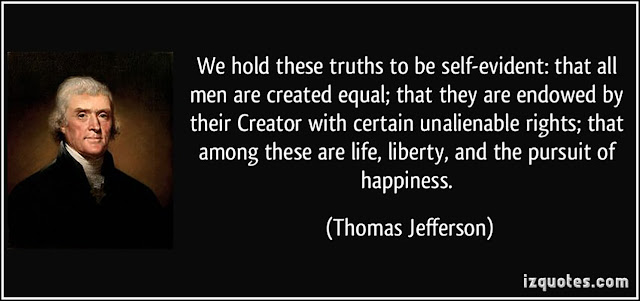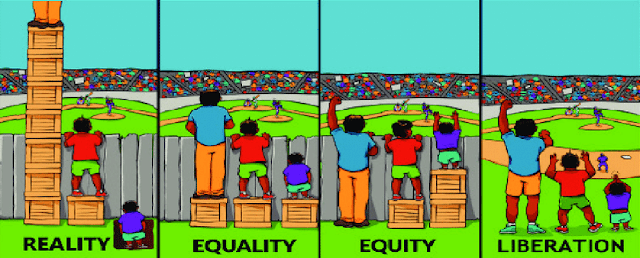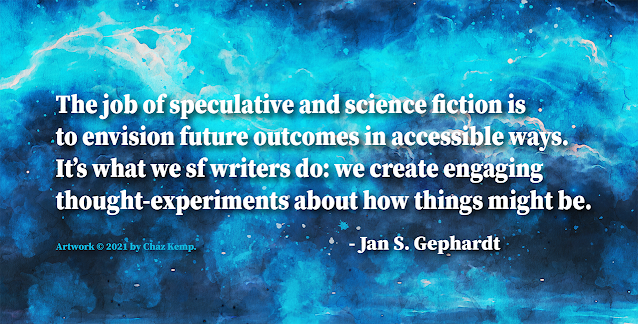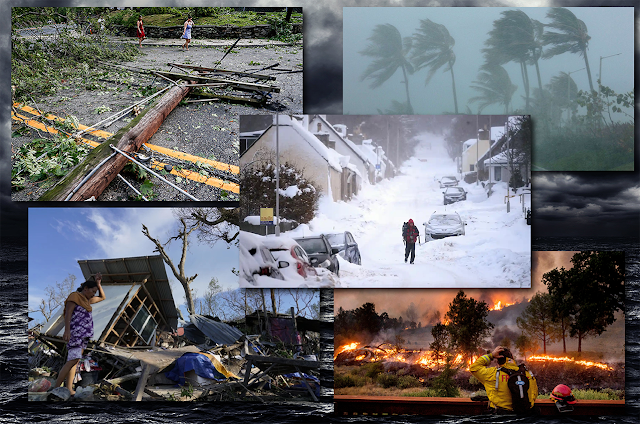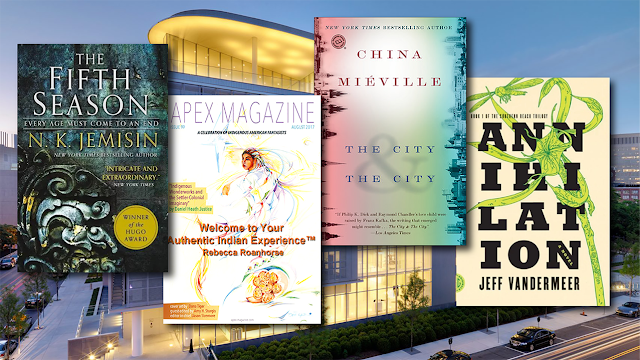By G. S. Norwood
I have chosen to live in the Lone Star State for more than thirty years. Since I wasn’t born and raised here, I have something of an outsider’s view when it comes to the cultural norms of White Texas society. It doesn’t take much observation to realize that more than a few things about my adopted state are . . . well, kinda screwy. It’s enough to make a rational gal like me ask, “Is Texas crazy?”
Weather
Every state in the union claims the old adage, “If you don’t like the weather, wait a minute.” But Texas weather really does go to extremes. Just over a year ago, Texas was suffering through what we now unlovingly refer to as the Great Texas Deep Freeze. Temperatures got extremely low for a state this far south. The electric grid nearly collapsed from the demand for heat.
And then things got dangerous. In one of the most prosperous states in our technologically-advanced country, more than 4 million people lost power—some of them for days on end. Nearly 250 people froze to death as a result of the storm, and I’m not talking about street sleepers. When your house has no heat for more than 24 hours, anyone can become vulnerable. Read about my own experience in last year’s blog post, Surviving a Not-So-Natural Disaster.
 |
| Is Texas crazy? When it comes to the weather, “Yes!” (See credits below). |
The weather isn’t usually that severe, but it can still be a little wacky. Take this week, for example. On Monday, we’ll have cloudy skies, but the daytime high will hit somewhere close to 80°F. On Wednesday and Thursday we can, if we believe the forecast icons, expect giant ice meteors—or at least sleet—despite the fact that the daytime temps could reach the 40s. Is Texas crazy? When it comes to the weather, I have to say, “Yes!”
Where the East Peters Out
Culturally, Texas can also show signs of a split personality. To a lot of people, Texas means cowboys, or at least a cowboy lifestyle—boots, jeans, Stetson hats. “Yes ma’am,” and “all y’all.” But in today’s Texas, that cowboy thing is only a reality in the western part of the state. Legendary Fort Worth journalist Amon Carter declared “Fort Worth is where the West begins,” and he had a point. Out on the open plains beyond Fort Worth, ranching is still big business, although many folks have traded in their horses for a good Ford F-150 pickup truck.
But if Fort Worth is where the West begins, that means Dallas is where the East peters out, and there’s some truth to that as well. Despite the popular television franchise, Dallas isn’t really about oil. Dallas is about oil money. Before that, it was about cotton money. Or cattle money. Any kind of money, really. Dallas built itself on banking and commerce, and it looked eastward for inspiration when the city fathers sought to position Dallas as a center of civilization, not a crude outpost on the far frontier. They built churches and founded symphonies. They established art museums and created retail stores that became legendary for their fashion and flair.
West of Fort Worth, folks might still greet you with a friendly “hahdie.” The only one in Dallas who still says “Howdy” is Big Tex.
So, is Texas about cowboys? Or is it about the sleek trappings of modern wealth? It’s both, really. As well as the hippie vibe and high tech of Austin, and the deeply rooted Hispanic culture of San Antonio. It’s about all of it, from haute cuisine to street tacos and barbecue joints. Texas is a big state, with room for multitudes.
 |
| Non-Texans can only gape in awe at the size, colors, and endless, creative variety that makes each Homecoming Mum and Garter an amazing production. (See credits below). |
Homecoming Mums
Some Texas stuff, however, is just inexplicably weird. There’s the way everybody automatically claps four times in the middle of singing Deep in the Heart of Texas. Or high school football games, which are far more popular and important to most people than anything those professional guys in the blue and silver uniforms do.
Maybe it’s because high school football is such a big deal that high school homecoming celebrations have become such a big deal, too. And the biggest big deal of any high school homecoming celebration in Texas is the Homecoming Mum.
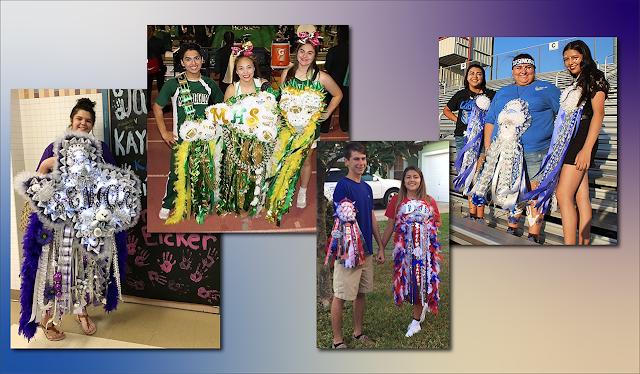 |
| All over Texas, every year they’re in high school, teens of all genders create or buy and proudly display their Homecoming mums and garters. (See credits below). |
Not content to drape young ladies in a simple corsage at homecoming, Texans build huge, elaborate floral . . . Things. With ribbons, and charms, lights and teddy bears and . . . Stuff. Sometimes the mums are bigger than the girls who wear/carry them. Sometimes the mums come as part of a suite of flowers, including armlet garters for the guys. Some Texas mothers have been known to start home-based businesses to feed the Homecoming Mum mania. Is Texas crazy? When it comes to Homecoming Mums, the answer is definitely, “Yes!”
So, Is Texas Crazy?
Any state that keeps re-electing politicians who ignore a failing foster care system, but obsess about where transgender people go to pee, has to have a large ration of crazy in the mix. At the same time, any state that can produce a fierce fighter for civil rights like Opal Lee has to offer up an equally large serving of vision and humanity. Thanks to Opal Lee, Juneteenth—an observance I had never heard of until I moved to Texas—is now a national holiday. Who can’t get behind a day that celebrates the end of human enslavement in our nation? Shouldn’t we all at least raise a beer to that?
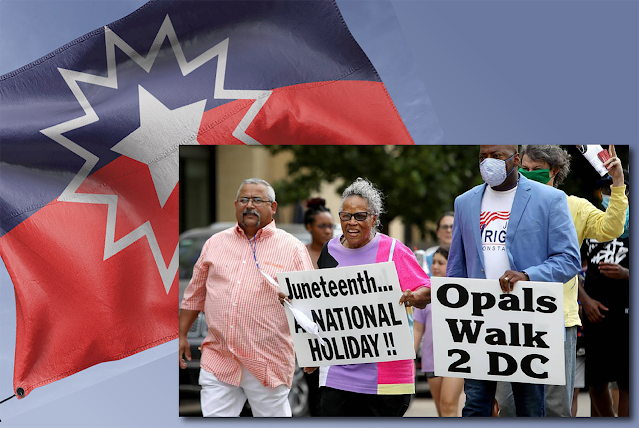 |
| The amazing Texan, Opal Lee, persisted until Juneteenth became a national holiday. (See credits below). |
Texas is the second fastest-growing state in the country. Even in these pandemic years, when many people have chosen to hunker down wherever they are and stay in familiar surroundings, the Texas Relocation Report 2021 estimates that more than 500,000 people moved to Texas in 2019. That was the seventh year in a row to see the new Texas residents top 500,000. Folks come here to find better jobs, more affordable housing, warmer weather, or just a wide-open horizon that promises all kinds of possibilities.
 |
| Texas is the second-fastest-growing state in the USA. Is Texas crazy? Or are people simply crazy about it? (illustration courtesy of Reform Austin). |
Is Texas is crazy? Yes! It’s crazy big, and crazy diverse, and it can swing from horrifying to hilarious at a moment’s notice. It has crazy weather and crazy customs. And it’s jam-packed with wonderful, awful, loveable, deeply human people from all over the world, who bring all their baggage with them when they come. Is it any wonder so many people move here? For now, at least, I wouldn’t want to live anywhere else.
IMAGE CREDITS
We have a lot of people to thank for the photos and other images in this post. All of the montages were designed and assembled by Jan S. Gephardt. For the “Weather Memes” illustration, we are indebted to Austin.com for “one weekend in Austin;” to Digital Mom Blog for the “-1 to 70” and “Powerball Numbers” memes; to Wide Open Country for “two seasons alternate days,” and to a “Dallas” subreddit for the “Texas Weather Last Week/This Week” meme. G. did a screen-grab of whatever weather app she has on her phone for the “week’s weather forecast with ‘ice-meteor’ icons.” The Texas flag that underlies them came from the Belson company.
The ”Fort Worth and Dallas” montage includes photos of the Dallas and Ft. Worth urban centers, both courtesy of Ted Bauer and White Rock Locators. “Hello Little Home” contributed the photo of Big Tex, without whom it just wouldn’t be the State Fair. We’d like to thank “Land and Farm” for the photo of the rural land in Collin County, TX that backs the Dallas photo. Jan took the photo that backs the Ft. Worth photo in March, 2005, not far from where G. and Warren lived at that time.
Those Mind-Blowing Homecoming Mums!
Jan admits she went a little, um, yes, crazy with the Homecoming Mum pictures, but the extravagant creativity and variety made it hard to narrow them down. In the first montage, Misty Owen created the “M”-emblazoned, orange-black-and-white mum her daughter holds in the picture, and sent the photo to the Dallas Morning News. I’m indebted to The Colt News for the group of four young women with their mums at their school’s Homecoming breakfast; they didn’t name the young ladies or their school. Young men’s garters are only somewhat less elaborate than their female dates’ mums, as you can see from the poolside photo of Emily and David (no last names or locations given). Many thanks for it from "Texas Traditions" on Facebook.
In the second Homecoming Mums montage, the ambitious and resourceful young woman whose corsage almost seems to be wearing her is Brittany Eicker. Her “Texas” mum made the Wall Street Journal, although she also showed up on at least one other website, too. The photo of the grinning trio from “MHS” came courtesy of My San Antonio. And the Hays Free Press provided the red-white-and-blue mum and garter pair, as well as the trio of Lehman High School Lobos boosters, L-R, Faith Parra, Sarah Miranda, and Rosa Fabian. Many thanks to all!
More Texas Topics
The amazing Opal Lee and her Juneteenth project provide plenty of inspiration, including for the fifth montage. At left, the official Juneteenth Flag is full of symbolic meaning. The photo of this particular flag is courtesy of North Carolina State College of Education. The Ft. Worth Star-Telegram provided the Amanda McCoy photo of Opal Lee leading a group down Lancaster Avenue in Ft. Worth on June 19, 2020.
Finally, we thank Reform Austin for the illustration-map showing places large groups of new Texans have left behind, and how many did so in a recent year (probably 2019 or 2018).

